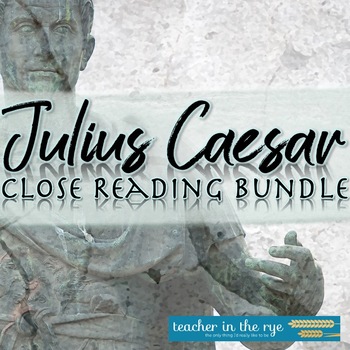Julius Caesar Complete Unit Bundle Packets Questions Quizzes Exam Essay Prompts
- Zip
Products in this Bundle (9)
showing 1-5 of 9 products
Description
The Tragedy of Julius Caesar, William Shakespeare's dramatic exploration of Rome's infamous dictator, is both historically rich and dynamically entertaining. The ideas of honor and loyalty are explored, as well as manipulation and tyranny in politics and in life.
This complete unit of close reading packets is meant to enhance students' understanding of not just the Elizabethan English Shakespeare used, but the power behind the words in light of the subject matter.
You will receive the following materials in this bundle (pages in parentheses):
ACT ONE
- Pre-Reading: Historical Background Info and Student Response Sheet (1)
- Pre-Reading: Themes from the Play and Real Life Quick Write (1)
- During Reading: Quote Studies and Close Reading Questions - Students respond to prompts aligned with quotes from the play which emphasize different literary elements (6)
- Post-Reading: Questions about the Act, both Comprehension and Analysis (2)
- Post-Reading: Multiple Choice Quiz, 22-question quiz that includes matching, quote identification, comprehension questions, and T/F (2)
- Answer Keys included
ACT TWO
- Pre-Reading: Prediction for Act Two Quick Write (1)
- During Reading: Quote Studies and Close Reading Questions - Students respond to prompts aligned with quotes from the play which emphasize different literary elements (7)
- Post-Reading: Quick Write about Suspense (1)
- Post-Reading: Questions about the Act, both Comprehension and Analysis (2)
- Post-Reading: Multiple Choice Quiz, 21-question quiz that includes matching, quote identification, comprehension questions, and T/F (2)
- Answer Keys included
ACT THREE
- Pre-Reading: Act Three Quick Write (1)
- During Reading: Quote Studies and Close Reading Questions - Students respond to prompts aligned with quotes from the play which emphasize different literary elements (6)
- Post-Reading: Quick Write about Character (1)
- Post-Reading: Questions about the Act, both Comprehension and Analysis (2)
- Post-Reading: Multiple Choice Quiz, 20-question quiz that includes matching, quote identification, comprehension questions, and T/F (2)
- Answer Keys included
ACT FOUR
- Pre-Reading: Act Four Quick Write (1)
- During Reading: Quote Studies and Close Reading Questions - Students respond to prompts aligned with quotes from the play which emphasize different literary elements (5)
- Post-Reading: Quick Write about Character (1)
- Post-Reading: Questions about the Act, both Comprehension and Analysis (2)
- Post-Reading: Multiple Choice Quiz, 20-question quiz that includes matching, quote identification, comprehension questions, and T/F (2)
- Answer Keys included
ACT FIVE
- Pre-Reading: Act Five Quick Write (1)
- During Reading: Quote Studies and Close Reading Questions - Students respond to prompts aligned with quotes from the play which emphasize different literary elements (5)
- Post-Reading: Quick Write about Character (1)
- Post-Reading: Questions about the Act, both Comprehension and Analysis (2)
- Post-Reading: Multiple Choice Quiz, 20-question quiz that includes quote identification, comprehension questions, and T/F (2)
- Answer Keys included
WHOLE PLAY SUPPLEMENT
This supplement is meant to enhance students' understanding of the power behind the usage, language, and literary elements in famous passages from the text.
The following passages are examined through the words of Antony, Brutus, Caesar, and Cassius:
- Passage One: Act I, Scene 2, lines 135-141
- Passage Two: Act 2, Scene 1, lines 162-166
- Passage Three: Act Two, Scene Two, lines 32-37
- Passage Four: Act 3, Scene 2, lines 182-187
- Passage Five: Act 3, Scene 1, lines 254-260
- Passage Six: Act 4, Scene 3, lines 216-222
The following language and literary terms are examined in the above passages:
- Simile
- Imagery
- Definition
- Paraphrasing
- Metaphor
- Usage
- Personification
- Foreshadowing
- Extended metaphor
- Word choice
- Figurative vs. literal
ESSAY PROMPTS
Six challenging, thoughtful, and varied options for a final assessment on Julius Caesar. Also can be used as in-class essays. Rubric included.
FINAL UNIT EXAM
This 35-question multiple choice test is comprehensive, challenging, and ready to use. Includes key and answer sheet. Just print a class set of the test, and answer sheet for each student.
Students can use their completed work to study for the quizzes and exam. This material can be used as individual student packets, or in small groups to aid in interpretation of the play and a greater understanding of the plot, motivations of characters, and literary devices.
Answer keys included for during and post-reading materials. Writing responses will vary.
Please see previews for a closer look.
Thank you,
Teacher in the Rye
Follow me for updates and new products for your MS or HS English classroom!





